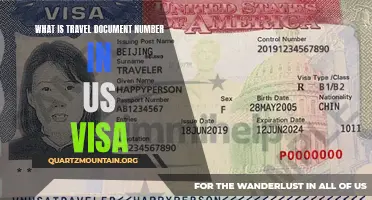
When it comes to traveling abroad, there are often a lot of terms and regulations that can seem confusing or overwhelming. One common source of confusion is understanding the difference between a travel document and a visa. While these two terms are often used interchangeably, they actually refer to different aspects of traveling internationally. In this article, we will explore what each term means and how they are distinct from each other. Whether you are a frequent traveler or simply curious about the intricacies of travel regulations, understanding the difference between a travel document and a visa can prove invaluable.
What You'll Learn

Understanding Travel Documents and Their Purpose
When it comes to traveling internationally, it's important to have the right paperwork in order. One common source of confusion is understanding the difference between a travel document and a visa. While these terms are often used interchangeably, they actually refer to different things. In this article, we will break down the differences between travel documents and visas, and explain their respective purposes.
A travel document is an official identification document that allows individuals to travel across national borders. It serves as proof of identity and citizenship, and is issued by the government of the individual's home country. Common examples of travel documents include passports and national identity cards.
The most commonly recognized travel document is the passport. A passport is a booklet that contains personal information, such as the individual's full name, date of birth, and photograph. It also includes important identification numbers and is usually valid for a set period of time, typically 10 years for adults and 5 years for children.
National identity cards, on the other hand, are typically issued by countries within the European Union. These cards serve as both a travel document and a form of national identification. They contain personal information, a photograph, and a unique identification number.
A visa, on the other hand, is an endorsement or stamp issued by a foreign country that allows an individual to enter, stay, or work in that country for a specific period of time. Visas are typically affixed to a page in the traveler's passport, although some countries now issue electronic visas that are linked to a traveler's passport via an electronic database.
The purpose of a visa is to regulate and control the entry of foreign nationals into a country. It is typically required for visits beyond a certain duration or for specific purposes, such as tourism, business, or study. The specific requirements for obtaining a visa vary depending on the country and the purpose of the visit.
Understanding the Relationship Between Travel Documents and Visas
While a travel document, such as a passport, is necessary for international travel, it does not automatically grant a traveler the right to enter a foreign country. In order to enter a country, a traveler may also be required to obtain a visa. In other words, a travel document is a necessary prerequisite for obtaining a visa, but the visa itself is a separate authorization.
For example, if a citizen of Country A wishes to travel to Country B, they will need a valid passport issued by Country A to establish their identity and citizenship. Additionally, they may need to obtain a visa issued by Country B to gain entry and stay for the desired duration.
In conclusion, understanding the difference between travel documents and visas is essential for anyone considering traveling internationally. A travel document, such as a passport, serves as proof of identity and citizenship and is issued by an individual's home country. A visa, on the other hand, is an endorsement or stamp issued by a foreign country that allows an individual to enter, stay, or work for a specific period of time. Both travel documents and visas are important pieces of paperwork that international travelers need to navigate the complex world of international travel.
Traveling from the US to Canada: Can I Enter with a US Visa?
You may want to see also

Differentiating Travel Documents and Visa Requirements
When it comes to international travel, there are often various requirements that need to be met in order to enter a foreign country. Two common terms that often come up in these discussions are travel documents and visa requirements. While they are related, they are not the same thing. In this article, we will differentiate between travel documents and visa requirements to help clarify their distinct roles and importance in international travel.
Travel Documents Explained
Travel documents are official papers that are required for international travel. They serve as identification and proof of citizenship or nationality. Common examples of travel documents include passports and national identification cards. These documents are issued by the government of your home country and contain personal information such as your name, date of birth, photograph, and nationality.
A passport is the most recognized travel document. It is a booklet that allows you to travel internationally and serves as proof of your identity and citizenship. Passports are typically required by immigration authorities when entering or leaving a country. They are primarily used for leisure or business travel and are valid for a specific period of time, usually ten years for adults and five years for children.
National identification cards are another form of travel document, although they are only accepted in specific regions or countries. These cards are issued by the government and provide proof of citizenship or residency. They are usually smaller and more convenient to carry than a passport. Some countries, like European Union member states, accept national identification cards for travel within the region.
Visa Requirements Explained
Visa requirements, on the other hand, are additional documents or permits that allow you to enter a foreign country for a specific purpose and duration. A visa is usually issued by the government of the country you plan to visit and can be obtained prior to your trip or at the point of entry.
A visa serves as permission to enter a foreign country, but it does not guarantee entry. It grants you the right to present yourself at the border or point of entry and request permission to enter the country. Immigration officials have the final say on whether you can enter or not, based on the information provided during the visa application process and at the border.
Visa requirements vary depending on the country you wish to visit, your nationality, the purpose of your trip, and the duration of your stay. Some countries have visa-free agreements with certain countries, allowing citizens to enter without a visa for a specific period of time. In other cases, a visa may be required, and the application process may include providing documents such as a valid passport, proof of accommodation, proof of financial means, and a travel itinerary.
In summary, travel documents are the identification documents that prove your citizenship or nationality, such as a passport or national identification card. They are required for international travel and are issued by the government of your home country. On the other hand, visa requirements are additional documents or permits that grant you permission to enter a foreign country for a specific purpose and duration. They are issued by the government of the country you plan to visit and can vary depending on factors such as your nationality and the purpose of your trip.
It is important to understand the difference between travel documents and visa requirements when planning your international travel. Make sure to check the visa requirements of the country you plan to visit well in advance and ensure that your travel documents, such as your passport, are valid and up to date. Failure to comply with visa requirements or travel document validity may result in being denied entry to a country or facing other inconveniences during your trip.
What You Need to Know About Traveling After Submitting Your Visa to Immigration
You may want to see also

Travel Documents: Passports, IDs, and Visas
When it comes to traveling internationally, there are several essential documents you need to have in order to ensure a smooth and hassle-free journey. These documents include passports, identification cards (IDs), and visas. While they are all important, they serve different purposes and it is important to understand the distinctions between them.
Let's start with passports. A passport is an official government-issued document that serves as proof of your citizenship and identity. It contains your personal information, including your full name, date of birth, photograph, and signature. A passport is required for international travel and serves as a form of identification when entering or exiting a country. It also allows you to seek assistance from your country's embassy or consulate while abroad.
Obtaining a passport requires applying through your country's passport office or relevant authority. The process usually involves submitting an application form, providing necessary supporting documents, and paying a fee. Passports generally have an expiration date, and it is important to renew your passport well in advance of its expiration to avoid any travel disruptions.
Next, let's discuss identification cards (IDs). IDs are typically issued by your government and serve as proof of your identity within your country. They often contain your name, photograph, signature, and unique identification number. IDs are primarily used for domestic purposes, such as opening bank accounts, voting, or proving your age when purchasing age-restricted items. While an ID may be accepted as a form of identification in some situations while traveling internationally, it is not a substitute for a passport.
Lastly, we come to visas. A visa is a travel document that grants you permission to enter a specific country for a specified purpose and duration. Visas are typically obtained from the embassy or consulate of the country you wish to visit. The requirements and process for obtaining a visa vary depending on the country you are visiting and the purpose of your trip, such as tourism, business, or study. It is important to research and understand the visa requirements of your destination country well in advance of your trip to ensure you have enough time to obtain the necessary visa.
A visa is typically stamped or affixed to a page in your passport and specifies the dates of validity and the number of entries allowed. Some countries may also require additional travel documents, such as a return ticket, proof of accommodation, or proof of sufficient funds. It is important to carefully review the visa requirements and ensure you have all the necessary documents before traveling.
In summary, while passports, IDs, and visas are all important travel documents, they serve different purposes. A passport is a proof of citizenship and identity, required for international travel. An ID is a proof of identity within your country and may be accepted as a secondary form of identification while traveling. A visa grants you permission to enter a specific country for a specified purpose and duration. Understanding the distinctions between these documents will help ensure a smooth and successful journey.
Exploring Canada's Beauty: Can I Travel to Canada on a US Visa?
You may want to see also

How to Obtain the Necessary Travel Documents for International Trips
Traveling internationally can be an exciting experience, but before you can embark on your journey, it is important to ensure that you have obtained the necessary travel documents. In general, there can be some confusion when it comes to differentiating between a travel document and a visa. While they are related, they serve different purposes. In this blog post, we will delve into what each document entails and provide you with a step-by-step guide on how to obtain them.
A travel document is an official document issued by a country's government that allows you to travel internationally. This document serves as proof of your identity and citizenship and is required for you to enter and exit countries. Examples of travel documents include passports and refugee travel documents. It is important to note that not all countries accept the same types of travel documents, so it is crucial to check the entry requirements of your destination country before proceeding.
On the other hand, a visa is an endorsement or stamp that is placed in your passport, granting you permission to enter a specific country for a certain purpose and duration. Visas are typically required if you are traveling to a country that is different from your country of citizenship or permanent residence. Obtaining a visa involves filling out an application, providing supporting documents, and possibly attending an interview at the embassy or consulate of the destination country.
Now that we have clarified the difference between a travel document and a visa, let's walk through the step-by-step process of obtaining them.
Step 1: Determine the type of travel document you need
The first step in obtaining the necessary travel documents is to determine what type of document you need. In most cases, a passport is required. If you are a citizen of a country that does not require a passport for international travel, you may still need a refugee travel document or a re-entry permit. Visit the website of your country's government or contact their relevant department to confirm the specific travel document requirements.
Step 2: Gather the required documents
Once you have identified the type of travel document you need, gather the required documents. This usually includes identification documents such as birth certificates, proof of citizenship or permanent residence, and passport-sized photos. Make sure to follow the specifications provided by the issuing authority to avoid any delays or rejections.
Step 3: Complete the application
Fill out the application form for the travel document accurately and completely. Be prepared to provide personal information, travel plans, and other details as required. Double-check the form for errors before submitting it.
Step 4: Submit the application
Submit the completed application form, along with the required supporting documents, to the appropriate government office or embassy. Be aware of any applicable fees and make sure to pay them accordingly. Depending on the type of travel document, it may take several weeks or even months for it to be processed, so it is advisable to apply well in advance of your planned trip.
Step 5: Attend any necessary appointments or interviews
Some travel documents, such as visas, may require you to attend an appointment or an interview at the embassy or consulate of the destination country. Make sure to schedule these appointments and arrive on time. Dress appropriately and bring any additional documents or evidence that may be required.
Step 6: Check the status of your application
After submitting your application, keep track of the status by checking the government's website or contacting the relevant office. If there are any issues or delays, follow up promptly to ensure that your application is processed in a timely manner.
Step 7: Receive your travel document
Once your application is approved, you will receive your travel document. Verify that all the information is correct, including the spelling of your name and the validity dates. If there are any errors, contact the issuing authority immediately for corrections.
In conclusion, obtaining the necessary travel documents for international trips involves understanding the difference between a travel document and a visa and following a step-by-step process. By researching the requirements, gathering the necessary documents, completing the application accurately, attending any appointments, and staying informed about the status of your application, you can ensure a smooth and hassle-free travel experience. Remember to start the process well in advance to allow for any potential delays or complications. Now, you can make the most of your upcoming international adventure with peace of mind!
Options for Traveling to Australia After Your Visa Expired
You may want to see also







